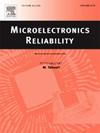Temperature-dependent characteristics and mechanisms in thin-barrier AlGaN/GaN MIS-HEMTs with LPCVD-SiN passivation layer
IF 1.9
4区 工程技术
Q3 ENGINEERING, ELECTRICAL & ELECTRONIC
引用次数: 0
Abstract
This paper investigates the temperature-dependent characteristics and degradation mechanisms of thin-barrier AlGaN/GaN metal–insulator–semiconductor high electron mobility transistors with low-pressure chemical vapor deposition SiN passivation layers on silicon substrate from 223 to 463 K. The channel current degradation in large gate-length devices is primarily attributed to mobility degradation. Through temperature-dependent field-effect mobility analysis, polar optical phonon scattering mechanism dominates at high temperatures, with an extracted optical phonon energy of 92.65 meV. Besides, the mechanisms of gate leakage current were studied. At temperatures above 373 K, slight increased gate leakage after pinch-off is dominated by two-dimensional variable range hopping, with the activation energy of 0.018 to 0.013 eV. While in the reverse bias region, trap-assisted tunneling (TAT) and Poole–Frenkel (PF) emission mechanism were found to dominate. The PF mechanism prevails above 403 K with a trap activation energy of 0.64 eV, while TAT dominates below 298 K showing the trap energy of 0.215 to 0.242 eV. In the medium forward bias region, defect-assisted tunneling (DAT) is the dominant mechanism. In the high forward bias region, TAT dominates with the trap energy ranging from 0.237 to 0.265 eV.
具有LPCVD-SiN钝化层的薄势垒AlGaN/GaN miss - hemt的温度依赖特性和机制
本文研究了在223 ~ 463 K的硅衬底上采用低压化学气相沉积SiN钝化层的薄势垒AlGaN/GaN金属-绝缘体-半导体高电子迁移率晶体管的温度依赖特性和降解机制。大栅极长度器件的通道电流退化主要是由于迁移率的退化。通过温度场效应迁移率分析,发现在高温下,极性光声子散射机制占主导地位,提取的光声子能量为92.65 meV。此外,还研究了栅漏电流的产生机理。在373 K以上的温度下,掐断后栅极漏电的轻微增加主要表现为二维变范围跳变,活化能为0.018 ~ 0.013 eV。而在反向偏置区,阱辅助隧穿(TAT)和Poole-Frenkel (PF)发射机制占主导地位。403 K以上以PF机制为主,捕获活化能为0.64 eV; 298 K以下以TAT机制为主,捕获活化能为0.215 ~ 0.242 eV。在中等正向偏置区域,缺陷辅助隧穿(DAT)是主要机制。在高正向偏置区,TAT占主导地位,捕获能量在0.237 ~ 0.265 eV之间。
本文章由计算机程序翻译,如有差异,请以英文原文为准。
求助全文
约1分钟内获得全文
求助全文
来源期刊

Microelectronics Reliability
工程技术-工程:电子与电气
CiteScore
3.30
自引率
12.50%
发文量
342
审稿时长
68 days
期刊介绍:
Microelectronics Reliability, is dedicated to disseminating the latest research results and related information on the reliability of microelectronic devices, circuits and systems, from materials, process and manufacturing, to design, testing and operation. The coverage of the journal includes the following topics: measurement, understanding and analysis; evaluation and prediction; modelling and simulation; methodologies and mitigation. Papers which combine reliability with other important areas of microelectronics engineering, such as design, fabrication, integration, testing, and field operation will also be welcome, and practical papers reporting case studies in the field and specific application domains are particularly encouraged.
Most accepted papers will be published as Research Papers, describing significant advances and completed work. Papers reviewing important developing topics of general interest may be accepted for publication as Review Papers. Urgent communications of a more preliminary nature and short reports on completed practical work of current interest may be considered for publication as Research Notes. All contributions are subject to peer review by leading experts in the field.
 求助内容:
求助内容: 应助结果提醒方式:
应助结果提醒方式:


